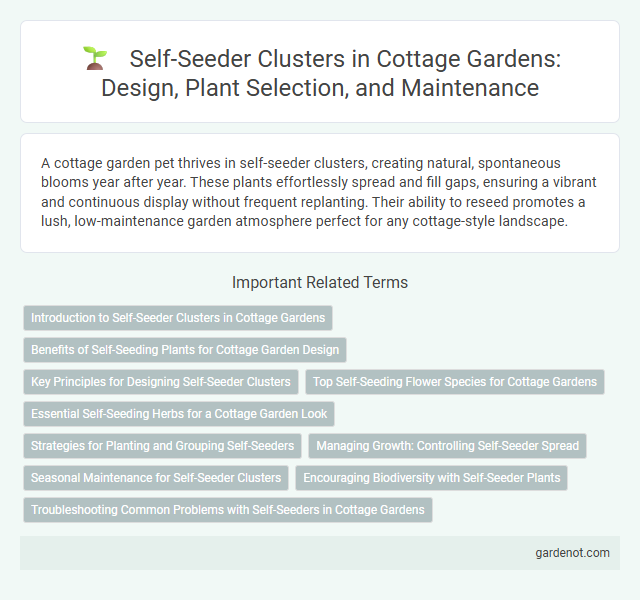A cottage garden pet thrives in self-seeder clusters, creating natural, spontaneous blooms year after year. These plants effortlessly spread and fill gaps, ensuring a vibrant and continuous display without frequent replanting. Their ability to reseed promotes a lush, low-maintenance garden atmosphere perfect for any cottage-style landscape.
Introduction to Self-Seeder Clusters in Cottage Gardens
Self-seeder clusters in cottage gardens naturally propagate plants by allowing seeds to disperse and grow without intervention, creating vibrant, ever-evolving floral displays. This approach supports biodiversity and enhances the garden's resilience by fostering a mix of annuals, perennials, and biennials that flourish year after year. Embracing self-seeder clusters reduces maintenance while promoting a harmonious balance of native and heirloom plant varieties typical of traditional cottage garden aesthetics.
Benefits of Self-Seeding Plants for Cottage Garden Design
Self-seeding plants create natural clusters that enhance the organic charm of cottage gardens by filling spaces with minimal effort. These plants reduce maintenance needs and promote biodiversity, attracting pollinators that support the garden's ecosystem. Their ability to regenerate annually ensures continuous, vibrant blooms, maintaining the quaint, informal aesthetic characteristic of cottage-style landscapes.
Key Principles for Designing Self-Seeder Clusters
Self-seeder clusters thrive by selecting plant species with reliable seed dispersal and high germination rates, ensuring continuous natural propagation. Balancing diversity with compatibility prevents competition and supports ecosystem health, while strategic spacing allows adequate sunlight and airflow for seedling growth. Incorporating native perennials boosts resilience and reduces maintenance, enhancing long-term sustainability in cottage garden designs.
Top Self-Seeding Flower Species for Cottage Gardens
Top self-seeding flower species for cottage gardens include cosmos, poppies, and foxgloves, known for their ability to naturally disperse seeds and create vibrant clusters year after year. These flowers enhance the cottage garden's charm by filling gaps with minimal maintenance, attracting pollinators such as bees and butterflies. Their adaptability to various soil types and conditions ensures continuous growth, making them ideal for sustainable, low-effort garden design.
Essential Self-Seeding Herbs for a Cottage Garden Look
Essential self-seeding herbs for a cottage garden look include thyme, chives, and cilantro, known for their reliable germination and natural spread. These herbs create dense, aromatic clusters that enhance the garden's informal charm while requiring minimal maintenance. Incorporating these self-seeders supports biodiversity and continuous harvests throughout the growing season.
Strategies for Planting and Grouping Self-Seeders
Planting self-seeders in clusters enhances natural propagation, promoting a lush and effortless cottage garden aesthetic. Grouping species with similar light, soil, and moisture needs ensures vigorous growth and minimizes maintenance. Strategic placement of resilient self-seeders near delicate perennials creates balanced, dynamic flower beds that thrive year after year.
Managing Growth: Controlling Self-Seeder Spread
Managing the spread of self-seeder clusters in a cottage garden involves strategic trimming and timely removal of excess seedlings to prevent overcrowding. Regular monitoring helps maintain plant health and ensures balanced growth without invasive spread. Applying mulch around established plants limits unwanted germination, preserving the garden's aesthetic and ecological harmony.
Seasonal Maintenance for Self-Seeder Clusters
Self-seeder clusters in cottage gardens require regular seasonal maintenance to thrive, including deadheading to prevent overcrowding and promote continuous blooming. Applying mulch during autumn conserves soil moisture and suppresses weeds, while light pruning in early spring encourages vigorous growth. Monitoring for pest infestations and removing any dead or diseased foliage ensures the health and sustainability of self-seeding plants year-round.
Encouraging Biodiversity with Self-Seeder Plants
Self-seeder clusters in a cottage garden promote natural regeneration by dispersing seeds that sprout season after season, reducing the need for replanting. These plants create diverse habitats that attract pollinators such as bees, butterflies, and birds, enhancing local biodiversity. Integrating native self-seeders like foxglove, columbine, and poppy supports resilient ecosystems and garden sustainability.
Troubleshooting Common Problems with Self-Seeders in Cottage Gardens
Self-seeder clusters in cottage gardens often face challenges such as uneven germination, overcrowding, and invasive growth. To troubleshoot, thin seedlings early to prevent competition for nutrients and ensure proper airflow, which reduces fungal diseases. Regularly monitor soil moisture to avoid both drought stress and waterlogging, promoting healthy self-seeder establishment.
Self-seeder cluster Infographic

 gardenot.com
gardenot.com